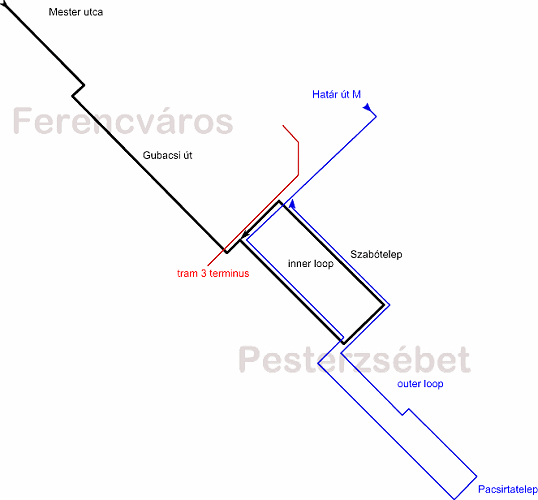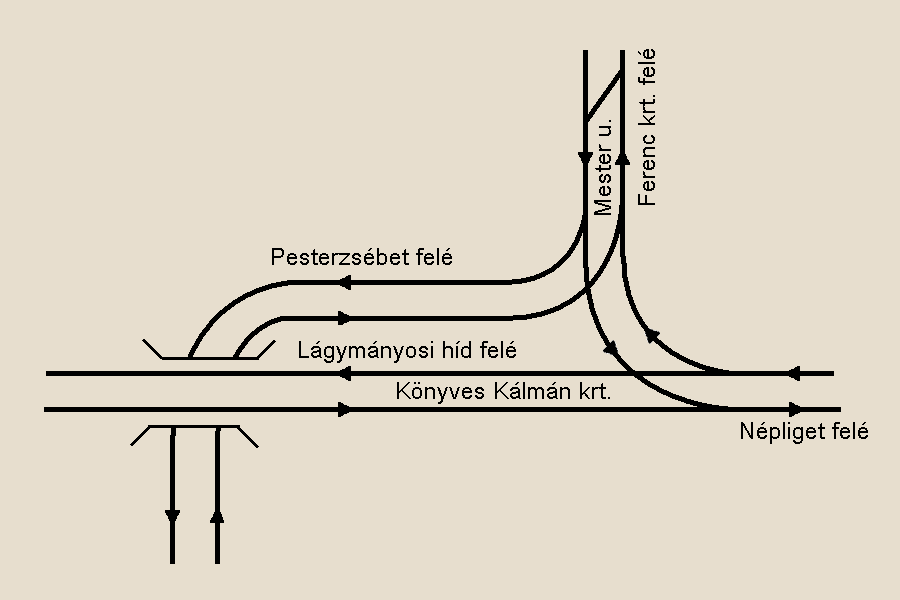 The
tram lines leading to Pesterzsébet have always been a highlight
for tram enthusiasts from abroad. If I should name one line in Budapest
with the strangest character, I would say route 51. And if I should decide, which tramline one
should avoid, I would also say route 51, because on the way it crosses
the skid row while taking some doubtful elements on board. Nowadays it's not so bad, but it's still wise for tram enthusiasts to blend in when riding alone, and not displaying a wide range of photo and film cameras hanging around the neck :)
The
tram lines leading to Pesterzsébet have always been a highlight
for tram enthusiasts from abroad. If I should name one line in Budapest
with the strangest character, I would say route 51. And if I should decide, which tramline one
should avoid, I would also say route 51, because on the way it crosses
the skid row while taking some doubtful elements on board. Nowadays it's not so bad, but it's still wise for tram enthusiasts to blend in when riding alone, and not displaying a wide range of photo and film cameras hanging around the neck :)
This line gives a quite edifying cross-section-view of Pest: it starts right at the Grand Boulevard, runs through the civic quarter of Ferencváros before reaching the former "slaughterhouse district" now pretty much torn down, sporting an alternating row of modern office buildings and empty sites. Then it makes its way along "The Mess" around Illatos utca, to reach what has remained of an industrial area, including an important weapon factory once called "lamp factory" to hide its purpose (although everybody knew what the place was). Then comes a row of communist-style high-rise apartment houses, and the quite interesting "giant loop" of Pesterzsébet, a gutter-running complex, what has been formed out of various tram and suburban railway lines..
The history of the Pesterzsébet loop is a complicated one, but the way there is a quite straight-forward story: the first stretch between the Grand Boulevard (Ferenc körút) and Ferencváros station via Mester utca was launched in 1900. Then it was extended to the Swine Slaughterhouse two years later. Two more years, and the line reached Pesterzsébet, featuring the forerunner of today's "inner loop" of Pesterzsébet, although used in the oppostite direction. The rest of the loop complex will be explained on a separate page, so we skip a few decades until 1994, when tram line 30 - until then doing today's route 51 - was extended to Pesterzsébet, Pacsirtatelep to supplement tram 31, which was closed at the same time. In 2000 an "inlay" service called 30A was launched between Ferenc körút and Könyves Kálmán körút to cater the new plaza (Lurdy Ház) there. 2005 saw tram 30 returning to its former path, not using the "outer loop" anymore. In 2008 bus and tram route designations were harmonised (=getting rid of parallely used numbers), therefore tram 30 was renamed to 21, tram 30A to 21A. In 2011 these services were again renumbered, to 51 and 51A.
On this page you might see the old route number appearing on photos, because I have more pictures of that era, than of today.
Route 51: Ferenc körút - Mester utca - Könyves Kálmán körút - Gubacsi út - Határ út - Török Flóris utca - Nagysándor József utca - Jókai Mór utca - Határ út, and then back 6.6 km + 8 km (due to the loop's nature, the line doesn't come back the same way as it went outwards)
Vehicles: 7 x TW6000
Home depot: Száva
Route 51A: Ferenc körút - Mester utca - Könyves Kálmán körút - Ferencváros vasútállomás 2.5 km
Vehicles: 2 x TW6000
Home depot: Száva
Remark: As mentioned earlier, this route crosses some "skid row" places, where it might be unwise to show up in the late hours, or to show off with expensive photo equipment at any time of the day. Also, Szabadkai út near the Gubacsi út/Határ út terminus of route 3 is a "grace area" where prostitution is allowed by the local government - they might not like people with cameras around.
![]()
The inner terminus lies right at the Grand Boulevard - in fact it's connected to it: this is one of the two connections for the depot rides of route 4/6.
The track layout might seem strange, but with a bit of imagination you can make out that this used to be a three-track terminus (until the seventies, I think), with one of those tracks given up to make room for vehiclular traffic. The lights are best in the morning - during other times of the day the houses cast strong shadows on the trams.
-> Over to route 4/6 on the Grand Boulevard
Mester utca is one of the more civic neighbourhoods of Ferencváros, historically known for cheap housing for labourers and poor people. Architectually it's even more interesting than Ferenc körút, the adjoining section of the Grand Boulevard.
For a while tracks run on one side of the street, then they change for the middle strip.
Ecer since the rehabilitation of Ferencváros started, this stretch looks quite okay.
After two stops we cross tram 24 in Haller utca, with an interesting layout best suited for depot rides:
-> Over to route 24 in Haller utca
Tracks run on the (other) side of Mester utca after this. Around 10 o'clock and 1500PM you can see lots of depot rides here (mostly of route 2/2A and 24). Usually you'll see more depot-bound trams than scheduled ones then :)
The stop Könyves Kálmán körút is located in a kind of basin between two large malls and the ramp to Lágymányosi híd (bridge). The awkward crossing of streets has lead to an awkward track layout:

Track layout (C) by Balázs
Fejes, from villamosok.hu
As you can see, there's no direct connection between tram 1 and 51, which means depot rides of latter must reverse on the crossover in Mester utca.
This is where tram 51 and 51A part ways: the first turns west, while the latter joins tram 1 for one more stop. Originally tram 51 would have received a terminus near the large TESCO supermarket in Gubacsi út, but the Traffic Superintendence denied an approval for that, because the "terminus" is in fact a crossover in the middle of the street, which in the opinion of the Superintendence would necessitate expensive safety equipment, for which the BKV did not have the money. So, 51A instead terminates in front of the Ferencváros remise...
-> Over to route 1 (and 51A) in Könyves Kálmán körút
Tram 51 then passes under the ramp of tram 1, and turns into Gubacsi út.
| Lost
rails: Közvágóhíd
Közvágóhíd - literally "Central Slaughterhouse" - once featured quite a number of tram lines next to the suburban railway's terminus and a tram depot. And all this was located between two diverging railway lines, making the place a favorite for rail enthusiasts - and USAAF bomber squadrons in World War II. Still, most of the ruins seen around date from much later: the end of communism, when most of the industry here was given up. One of the most romantic (and now lost) tram places in the past was the alley-way at the feet of the railway embankment, through which tram 31 started out to Pesterzsébet... |
Gubacsi út used to be the industrial high-street of Ferencváros, now only a small number of those former industrial sites are used. The best time for taking photos here is in the morning.
| Lost
rails: Hentes utca
Hentes utca ("Butcher street" - remember I called the place the "slaughterhouse quarter"?) has a very similar (and short) history to Vágóhíd utca: it existed between 1906 and the end of World War I as a connection of the BKVT line in Soroksári út (now only used by the suburban railway to Ráckeve) to the Swine Slaughterhouse, to get around BVVV-concessioned Gubacsi út. |
There's a slight change of direction in Gubacsi út where the main entrance to the Swine Slaughterhouse used to be. This is where a short stretch on reservation starts - and where carless motorists often get stuck on the tram's private right-of-way when they follow the tram without mindig the markings on the street surface :)
Okay, and then comes the section, of which I don't have any photos: the blocks around Illatos út ("Fragrant street" - what an inapt name!), generally known as "The Mess" (Dzsumbuj). The name refers to a series of cheap flats built around 1937 to replace slums that came to existence after World War I, when 2/3rd of the country was cut off (Treaty of Trianon) and lots of refugees fled to Budapest. These blocks then turned into slums after the inhabitants with slowly gathered possessions moved out, with unemployed and homeless people taking their place. It then came to a point in the near past, when ambulance had had to be escorted by police to wounded inhabitants of the blocks. Fortunately a rehabilitation programme was started a few years ago, and the inhabitants are being repatriated to better vicinities, with the buildings set for demolition.
The light-brownish building in the background is the front row of "The Mess". That particular building (the first row of the battery) was torn down recently, but the rest remains, although with most of the windows and doors of the now-onuccupied flats bricked in.
There are less and less active industrial facilities around here, one can see buildings disappearing every year - I wonder when all these now-unused sites will be built in! There were grand-scale plans for some of them, but I believe most of them were abandoned due to the financial crisis in 2008.
And now we leave this section as we arrive to tram 3's terminus at Határ út - the name of which means "Boundary street": the old border between Budapest and the once-autonomous settlement of Pesterzsébet, incorporated into the capital in 1950. This is where the anachronistic "tram kingdom" of Pesterzsébet starts - but that is the subject of a separate webpage!
-> Over to route 3 at Gubacsi út/Határ út
![]()
Back to the
top
Back
to the opening page
Back
to the clickable map
Disclaimer: The author cannot
be held responsible for mistakes, misinterpretations, inaccuracies, inactualities,
etc. on/of these pages, nor for the content of other pages linked in.
Archive photos: Michael
J. Russell
Track layout drawings: BSzKRt
(collection of Dr. Zoltán Ádám Németh), BKV, Fejes Balázs
![]()
Send
a mail to the author
The
author's homepage